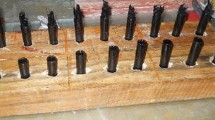Abstract
Polyetherimide composite is one of the most non-flexible and lightest composite materials which is difficult to machine by conventional machining process. This material has widespread applications in mechanical engineering, industries, etc. Polyetherimide composite has excellent properties of high-temperature stability, specific stiffness performance, high durability, corrosion resistance, wear resistance, high conductivity and self-lubrication. In the present investigation, 24-layered structured matrix was constructed and properties such as hardness and quality of carbon-fabricated composite structure using dry sliding method have been examined. Further, to testify its applicability in aviation and automobile industry the simulations were illustrated to comment on its mechanical strength. There is a reduction in coefficient of friction by 66.67% noticed at 70 N load, which is associated with surface modifications from frictional heating. Further, to examine and evaluate material’s stress and strain strengths a set of simulations were carried out with a maximum von Mises stress of 2145.4 GPa on ANSYS Workbench 18.1. Finally, it has been concluded that as the layers of the carbon fiber content increase, hardness along with wear resistance of reinforced carbon fiber for polyetherimide composites increases.















Similar content being viewed by others
References
H. Hocheng, C.C. Hsu, Preliminary study of ultrasonic drilling of fiber-reinforced plastics. J. Mater. Process. Technol. (1995). https://doi.org/10.1016/0924-0136(94)01657-M
P.J. Kim, D.G. Lee, J.K. Choi, Grinding characteristics of carbon fiber epoxy composite hollow shafts. J. Compos. Mater. 34, 2016–2035 (2000)
H. Wang, W. Cong, A study on the effects of machining variables in surface grinding of CFRP composites using rotary ultrasonic machining. Int. J. Adv. Manuf. Technol. 95, 3651–3663 (2018)
D. Kinet, P. Mégret, K.W. Goossen, L. Qiu, D. Heider, C. Caucheteur, Fiber Bragg grating sensors toward structural health monitoring in composite materials: challenges and solutions. Sensors (Switzerland) 14, 7394–7419 (2014). https://doi.org/10.3390/s140407394
J.P. Davim, P. Reis, Drilling carbon fiber reinforced plastics manufactured by autoclave-experimental and statistical study. Mater. Des. 24, 315–324 (2003). https://doi.org/10.1016/S0261-3069(03)00062-1
W.L. Cong, Z.J. Pei, Q. Feng, T.W. Deines, C. Treadwell, Rotary ultrasonic machining of CFRP: a comparison with twist drilling. J. Reinf. Plast. Compos. 31, 313–321 (2012)
W.L. Cong, Z.J. Pei, X. Sun, C.L. Zhang, Rotary ultrasonic machining of CFRP: a mechanistic predictive model for cutting force. Ultrasonics 54, 663–675 (2014). https://doi.org/10.1016/j.ultras.2013.09.005
W.L. Cong, Q. Feng, Z.J. Pei, T.W. Deines, C. Treadwell, Rotary ultrasonic machining of carbon fiber-reinforced plastic composites: using cutting fluid vs. cold air as coolant. J. Compos. Mater. 46, 1745–1753 (2012)
J. Liu, Y. Xian, D. Cao, J. Su, W. Liao, M. Ding, et al. Study of the design and torsion performance for carbon fiber composite material automobile drive shaft, in Society of Automotive Engineers (SAE)-China Congress (2016), pp. 303–312
X. Huang, Fabrication and properties of carbon fibers. Mater. (Basel) 2, 2369–2403 (2009). https://doi.org/10.3390/ma2042369
A. Quilter, Composites in Aerospace Applications. IHS White Pap (2001), p. 444
R. Hosseinzadeh, M.M. Shokrieh, L. Lessard, Damage behavior of fiber reinforced composite plates subjected to drop weight impacts. Compos. Sci. Technol. 66, 61–68 (2006)
X.F. Qin, Sun D. Le, L.Y. Xie, Analysis of critical stress for subsurface rolling contact fatigue damage assessment under roll/slide contact. J. Fail. Anal. Prev. 14, 61–67 (2014). https://doi.org/10.1007/s11668-013-9762-6
M.A. Arab, M. Zemri, M.M. Blaoui, Experimental investigation on the effect of tool rotational speed on mechanical properties of AA6082-T6 friction stir-welded butt joints. J. Fail. Anal. Prev. 18, 1625–1630 (2018). https://doi.org/10.1007/s11668-018-0562-x
Q.M. Zobaer Shah, M. Asaduzzaman Chowdhury, Kowser M. Arefin, Failure mechanism of polytetrafluoroethylene under friction fatigue. J. Fail. Anal. Prev. 19, 245–249 (2019). https://doi.org/10.1007/s11668-019-00595-0
T.C. Hanshaw, D. Roy, M. Toyooka, Software Models Impact Stresses (1991)
X. Dangsheng, Friction and wear properties of UHMWPE composites reinforced with carbon fiber. Mater. Lett. 59, 175–179 (2005). https://doi.org/10.1016/j.matlet.2004.09.011
D.E. Koelle, On the optimum cruise speed of a hypersonic aircraft. IEEE Aerosp. Electron. Syst. Mag. 4, 13–16 (1989)
S. Chandra, A. Lee, S. Gorrel, C. Greg Jensen, CFD analysis of PACE Formula 1 Car. PACE 1, 1–14 (2011)
J. Belan, Structural analyses of advanced material for aerospace industry. Medziagotyra 14, 315–318 (2008)
L. Ibarra, D. Panos, Dynamic properties of thermoplastic butadiene–styrene (SBS) and oxidized short carbon fiber composite materials. J. Appl. Polym. Sci. 67, 1819–1826 (1998)
B.K. Yen, Influence of water vapor and oxygen on the tribology of carbon materials with sp2 valence configuration. Wear 192, 208–215 (1996)
H.M. Hsiao, I.M. Daniel, Strain rate behavior of composite materials. Compos. Part B Eng. 29, 521–533 (1998). https://doi.org/10.1016/S1359-8368(98)00008-0
J. Harding, Effect of strain rate and specimen geometry on the compressive strength of woven glass-reinforced epoxy laminates. Composites 24, 323–332 (1993)
Author information
Authors and Affiliations
Corresponding author
Additional information
Publisher's Note
Springer Nature remains neutral with regard to jurisdictional claims in published maps and institutional affiliations.
Rights and permissions
About this article
Cite this article
Shard, A., Chand, R., Nauriyal, S. et al. Fabrication and Analysis of Wear Properties of Polyetherimide Composite Reinforced with Carbon Fiber. J Fail. Anal. and Preven. 20, 1388–1398 (2020). https://doi.org/10.1007/s11668-020-00943-5
Received:
Published:
Issue Date:
DOI: https://doi.org/10.1007/s11668-020-00943-5




